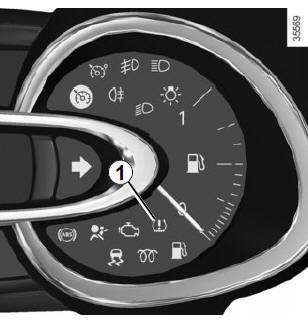Renault Clio: Tyre pressure loss warning

If fitted on the vehicle this system warns the driver of pressure loss in one or several tyres.
Operating principle
Each wheel (except for the emergency spare wheel) has a sensor in the inflation valve which periodically measures the tyre pressure while driving.
Warning light  1 comes on to
1 comes on to
alert the driver in the event of insufficient
pressure (deflated wheel, punctured
tyre, etc.).
Resetting the standard level for the tyre pressures
This should be done:
- when the standard tyre pressure needs to be changed to adapt to usage conditions (empty, carrying a load, motorway driving, etc.);
- after swapping a wheel (however this practice is not recommended);
- after changing a wheel.
It should always be done after checking the tyre pressure of all four tyres when cold.
Tyre pressures must correspond to the current usage of the vehicle (empty, carrying a load, motorway driving, etc.).
| This function is an additional
driving aid. However, the function does not take the place of the driver. It cannot, therefore, under any circumstances replace the vigilance or the responsibility of the driver. Check the tyre pressures, including the emergency spare wheel, once a month. |
Resetting procedure

With the ignition on:
- repeatedly press button 3 or 4 to select the “LEARNING THE TYRE PRESSURE” function on the display 2;
- press and hold (around 3 seconds)
button 3 or 4 to start initialisation.
Display of the message “PRESSURE REF ONGOING” indicates that the reset request for the tyre pressure reference value has been taken into account.
Reinitialisation is carried out after a few minutes’ driving.
Note: The standard tyre pressure cannot be less than that recommended and indicated on the door frame.
Display
The display 2 on the instrument panel informs you of any tyre pressure faults (flat tyre, punctured tyre, etc.).
ADJUST TYRE PRESSURE
Warning light  comes on, along
comes on, along
with the message “ADJUST TYRE
PRESSURE”.
These indicate that at least one tyre is flat.
Check and, if necessary, readjust the pressures of the four wheels when cold.
The warning light  goes off after a
goes off after a
few minutes’ driving.
| The sudden loss of pressure in a tyre (burst tyre, etc.) cannot be detected by the system. |
PUNCTURE
The warning light  comes on
comes on
steady, accompanied by the message
“PUNCTURE” and a beep.
They indicate that at least one wheel is punctured or severely underinflated.
Replace it or contact an authorised dealer if it is punctured. Top up the tyre pressure if the wheel is deflated.
This message is accompanied by the
warning light  .
.
Warning light  requires requires
you to stop immediately, for your own safety, as soon as traffic conditions allow. |
CHECK TYRE PRESSURE SENSORS
The warning light  flashes for
flashes for
several seconds, then stays on, along
with the message “CHECK TYRE
PRESSURE SENSORS”.
This message is accompanied by the
warning light  .
.
They indicate that at least one tyre is not fitted with sensors (e.g. emergency spare wheel). In other cases, contact an authorised dealer.
Readjustment of tyre pressures
The tyre pressures must be adjusted when cold (please refer to the label located on the edge of the driver’s door).
If tyre pressures cannot be checked when the tyres are cold, the recommended pressures must be increased by 0.2 to 0.3 bar (3 PSI).
Never deflate a hot tyre.
Replacing wheels/tyres
This system requires specific equipment (wheels, tyres, hubcaps, etc.).
Please see the information on “Tyres” in Section 5.
Contact an approved Dealer to fit new tyres and to find out about available accessories compatible with the system and available from your dealer network: the use of any other accessory could affect the correct operation of the system or damage a sensor.
Emergency spare wheel
If the vehicle is equipped with an emergency
spare wheel, it will not have a
sensor. When it is fitted on the vehicle,
the warning light  flashes for
flashes for
several
seconds, then stays on, together
with the warning light  and the
and the
message “CHECK TYRE PRESSURE
SENSORS” appears on the instrument
panel.
Tyre repair product and inflation kit
Because the valves are specially designed, only use equipment approved by the approved network. Please refer to the information on “Tyre inflation kit” in Section 5.

